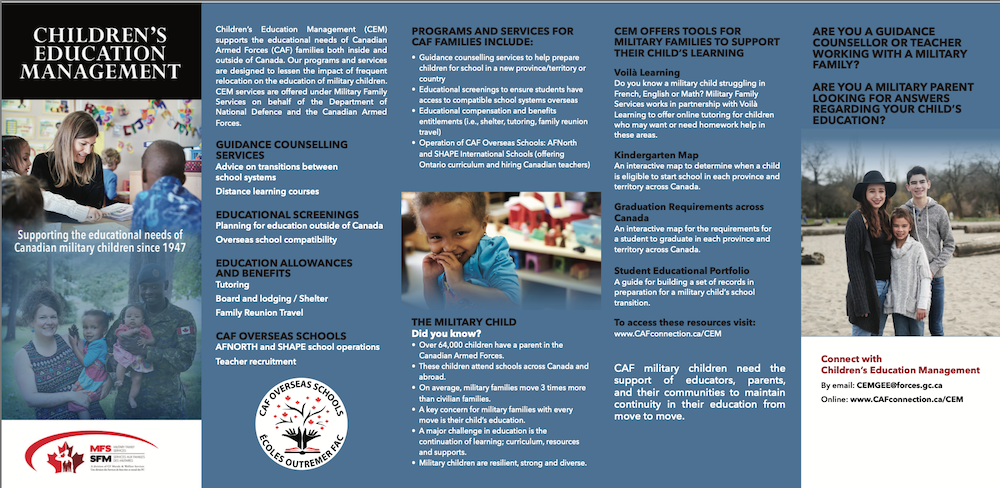CMF Kids
Children’s Education Management: Providing educational support for military children
 In 1947, Children’s Education Management (CEM) was established to support the educational needs of military children, and hundreds of schools were established both in Canada and abroad.
In 1947, Children’s Education Management (CEM) was established to support the educational needs of military children, and hundreds of schools were established both in Canada and abroad.
Today, over 71 years later, although only a handful of schools still exist under Department of National Defence (DND) operation, CEM still plays a vital role in the education of Canada’s military children, from serving as a fountain of information to providing financial support.
Established After the Second World War
CEM was established after the Second World War when thousands of Canadian soldiers remained behind in Europe. After the demand increased to have these soldiers reunite and live with their families on their foreign posting, the government at the time set down regulations allowing the minister of DND to run and operate schools. Over the next few decades, dozens of DND-operated schools popped up across Europe in countries like Germany, France, Belgium, and Holland.
For example, tutoring is covered for those students who are posted from one province to another and are struggling to keep up with their new province’s curriculum.
Additionally, those soldiers returning home found that their children were having difficulties accessing local schools as bases were not located close to the local towns. Therefore, DND-operated schools were built on every base across the country as well.
At its peak, the DND was running hundreds of schools both across Canada and overseas. However, DND’s operation of schools came to an end in 1993 after budget cuts were made and base schools were turned over to the local school boards.

Two Schools Remain Under CEM Operation
Today, only two schools remain under CEM operation: AFNORTH International School in Brussnum, Netherlands and SHAPE International School- Canadian Section in Casteau, Belgium. Both of these schools deliver Ontario curriculum and teachers are hired on two-year contracts from across the country. These teachers are typically the “crème de la crème” of Canada’s education sector.
In total, CEM spends up to $8 million on education allowances that include tuition, tutoring, and transportation.
Since CEM only operates two schools, the brunt of its work is to provide support on various other ways to the military community, or essentially, to contribute to the morale of Canadian Armed Forces’ (CAF) members.
“It contributes to the resiliency of the military member because the member doesn’t have to worry about their kid,” said Marc Bélanger, Director of CEM.
CEM’s Job is to Locate & Inspect Schools
Currently, there are close to 250 locations around the world where CAF members are stationed, and CEM’s job is to locate and inspect schools to ensure that Canadian children receive an education comparable to the Ontario school system. CEM has pinpointed compatible schools for every location around the world where CAF members might be posted.
Tuition for these schools, which are often private schools, is covered by CEM and can sometimes be up to $60,000 a year. In total, CEM spends up to $8 million on education allowances that include tuition, tutoring, and transportation.
Tutoring is Covered
Education allowances aren’t just reserved for those families posted outside of Canada. Families can take advantage of a number of benefits while posted in Canada as well. For example, tutoring is covered for those students who are posted from one province to another and are struggling to keep up with their new province’s curriculum.
“For example, if you’re posted from Gagetown to Petawawa, and your kid is in Grade 10, he will suffer in math and science because the Ontario curriculum is much stronger than that of New Brunswick or Nova Scotia. So, right there, families need to know your child might struggle with math and there’s tutoring available,” explained Bélanger.

Another Educational Allowance
Another educational allowance open to military children within Canada is for when families are posted away during their child’s last year of high school. If the parents choose to leave their child behind to finish up Grade 11 or 12, CEM will cover the cost of their board and lodging, up to $20,000.
“The example I give is the kid in Stittsville, he’s starting Grade 12, the family is posted out to Cold Lake. He’s got his hockey, he’s got everything, and family friends are just up to the road, so he’s going to stay back and finish his high school, simple as that, and we’ll pay,” commented Bélanger. CEM will also pay to reunite the child with their family a few times a year.
Benefits Available to Military Children Seeking Secondary Education
Certain benefits are also open to military children seeking a post-secondary education in Canada while their parents are posted OUTCAN. CEM will cover the cost of parents wishing to return to Canada to set up their child before university starts and will cover board and lodging for the child. They will also cover the cost of three trips for the student to visit their parent OUTCAN. This allowance is available up until the age of 23.
According to Bélanger, many parents are not taking advantage of the in-Canada benefits, and he strongly encourages parents to look into the options they have. CEM’s website contains a plethora of useful information, but education is also a strong component of CEM’s works as well.

Guidance Counselling Service
In 2015, CEM launched a guidance counselling service to keep families informed of their options. “We realized families were on their own having to navigate all this information, different curriculums,” said Bélanger.
CAF members and their families being posted OUTCAN are now required to speak with a CEM guidance counsellor before they are DAG’d green, or cleared to deploy. Guidance counsellors inform families of the benefits they’re entitled to and help them pick which school is best for their child in the new location. This service is especially important for high school-aged children so they can stay on track for graduating and achieving their post-secondary goals.
At its core, CEM’s goal is to lessen the impact frequent relocations have on the schooling of military children. To further this mission, Bélanger says they are currently working on creating a document that would greatly impact military children.
Families posted within Canada can also take advantage of the counselling services. In fact, CEM guidance counsellors will step in to speak with local guidance counsellors if a child is facing certain difficulties at their new school. Around 1,300 families have been served by CEM guidance counsellors since the program launched in the first two years of the program.
The counsellors are also currently on a mission to reach out to all schools located near CAF bases to give them a briefing on the military lifestyle, educational needs, mental health, the benefits to which they’re entitled, and anything related to military life that might affect the child.

Goal to Lessen Impact of Frequent Relocations
At its core, CEM’s goal is to lessen the impact frequent relocations have on the schooling of military children. To further this mission, Bélanger says they are currently working on creating a document that would greatly impact military children.
“In the U.S. they’ve created a compact on the education for military children. It’s not a legally binding document but it’s a huge document that each state has signed on to. Whereas a military child, say posted from Texas to Kansas City, they finish Grade 9 in Texas when they arrive in Kansas City they will automatically be placed in Grade 10 no matter what credit counts or difference in curriculum there are, for all military children,” explained Belanger.
CEM is working on creating a similar document for Canada and is looking to get on the agenda of the next Conference of the Ministers of Education to get provinces and territories to sign off on this document. This would greatly ease the burden many children face when moving from province to province and is just one more way to support military members and their families.
For more information visit CEM website here.





















